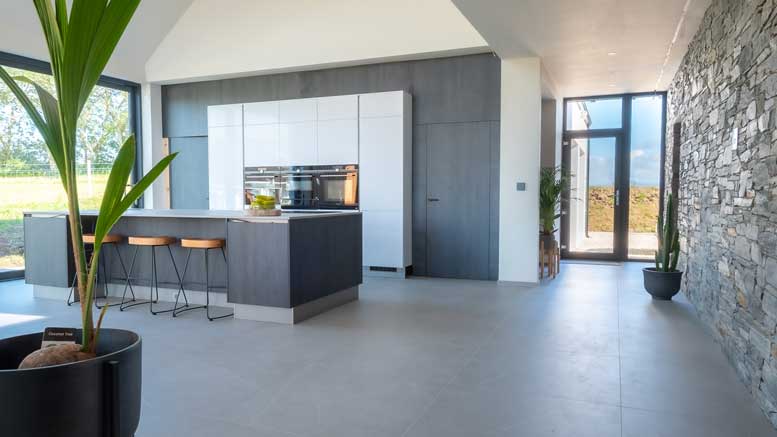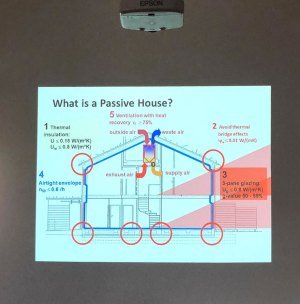From the outset we knew we wanted our new home to have lower running costs than the old one. As well as the obvious financial advantages, there is an environmental imperative for us all to use less energy too.
There are many standards and buzz words surrounding this area, Zero Energy, Low Energy, Zero Carbon and Carbon Neutral for example. A new standard that’s taking off in this part of the world (it’s already a requirement in the Republic of Ireland), is ‘nearly Zero Energy Buildings’ or nZEB.
But Passivhaus (Passive House) was the one we knew most about and it seems to be well recognised when you are discussing the specifications for a new self-build. However, many companies we talked to, including window manufacturers and energy consultants, cautioned us on the idea of going for a fully certified Passive House build.
This wasn’t because they thought a Passive House is a bad idea, on the contrary, but the phrase ‘diminishing returns’ was often quoted, while pretty much everyone universally agreed that we should still try to adopt the main principals for our own build.

Passive Principles
So let’s look at those principles. Here’s a slide from a talk I attended showing the 5 main principals of Passive House.
Very High Levels of Insulation
Passive houses are super insulated.
Thermal Bridge Free Construction
Their design and building methods eradicate junctions where a traditional building conducts heat away.
High Performance Windows / Frames
Passive House windows are triple glazed and the frames and fittings are all made for an ultra-low U value. In addition passive houses take advantage of solar gain using south facing windows.
Airtight Building Fabric
These houses are airtight, eliminating the traditional ‘drafty’ buildings of old. A passive house must not leak more air than 0.6 times the total house volume per hour.
Mechanical Ventilation System with Heat Recovery
Because these homes are air tight they need mechanical ventilation. These systems expel the stale air and moisture, replacing it with fresh air. This process happens across a heat exchanger so up to 85% of the heat is retained.
Design
While it’s possible to build a fully certified passive home in the style we wanted, it is more difficult and certainly more expensive.
As an example, one builder we talked to that had just completed a certified passive house told us certain design elements (like dormer windows) were much harder and more time consuming to build and hence more expensive to achieve in a certified Passive House. While we want low heating costs for the new Automated Home 2.0, we didn’t want that to be at the expense of our design and other features.
Masonry Construction
The 2 main passive house projects that I followed online (Ben Adam-Smith and Portree Passivhaus) had both gone for masonry construction.
Our last house had stud walls upstairs and a timber first floor which we always regretted as both were very noisy. So right from day one our wish list had been set out for solid walls and floors and we also spec’d concrete stairs to be sure of no squeaks or creaks there either.
That sound issue did colour our opinion on building timber frame too. Although having seen a beautiful timber frame home, recently built by a close family member, I’m sure that we could have been happy with one too.
Carbon for Build
Not going TF also meant having much more concrete in our build. There are massive amounts of embodied energy in most building materials – like steel and glass for example, although this will improve over time as more of our electricity comes from renewable sources. Concrete uses a chemical reaction called “calcination” that takes place during the process of making ‘clinker’, a vital part of concrete, that splits the material into calcium oxide and CO2 (here’s a good article from the BBC on concrete production). New methods are appearing that are improving the CO2 emissions for concrete production so things should improve here too in the future.
Interestingly the passive standard has absolutely nothing to say on the subject of reducing the carbon during construction. Its only concern is creating a building that won’t require much energy once built.
We used Fabric First approach and our block build, plus stone wall, tiled floor and overhang in the barn helps to soak up heat from the Winter sun and release it back into the house. We’re also running the heat pump more at night on our cheaper economy 7 electricity tariff and this is all working well. We got a 1.9 airtightness test rating in the end and our Heat Pump and MVHR are working well together to provide a very comfortable environment. I’m recording data for the year and should have an update sometime in January on our energy usage for 12 months.

Budgets & Compromise
As with so much in life, these decisions were a tightrope walk between the competing demands of maintaining our chosen design, our requirements for a low energy build and our finite budget.
Some of our choices have come down to payback time. If the cost of going from double to triple glazed windows will take, say 15 years to recoup via slightly lower heating bills, then would you go for it? If it’s 30 years instead then how about now? The point at which these things make sense will vary for the individual. Saying that, I do think the biggest compromise of our entire project has been our windows and having to settle for double glazing instead of triple.
We also want a Solar PV system, but that will have to wait. It’s a shame that there are zero incentives in Northern Ireland for heat pumps or solar PV etc. I think we’re the only part of the UK and Ireland not to have any. Perhaps the new Energy Strategy for NI coming later this year will change that.
As these building methods and products become more common here hopefully prices will fall. If we were starting again in the morning I’m pretty sure we would go even further towards the passive standard than we have done.
After living in the house for more than a year now we’re very happy that our decision Not to Burn Anything was the right one.
Low Energy?
Low energy? Eco house? These terms are not well defined. But we have a home which, at the very least, is really well insulated, takes advantage of solar gain in the winter, uses an intelligent building management system, runs only on electricity, has a good thermal mass and ultimately great comfort and air quality levels in summer and winter.

Next Time
Next time we’ll look at some of the new technology in the Automated Home. In the meantime remember to check out our Instagram to follow the project, read the rest of the Automated Home 2.0 blog posts and find the links to all the products we’ve used in our self-build.









